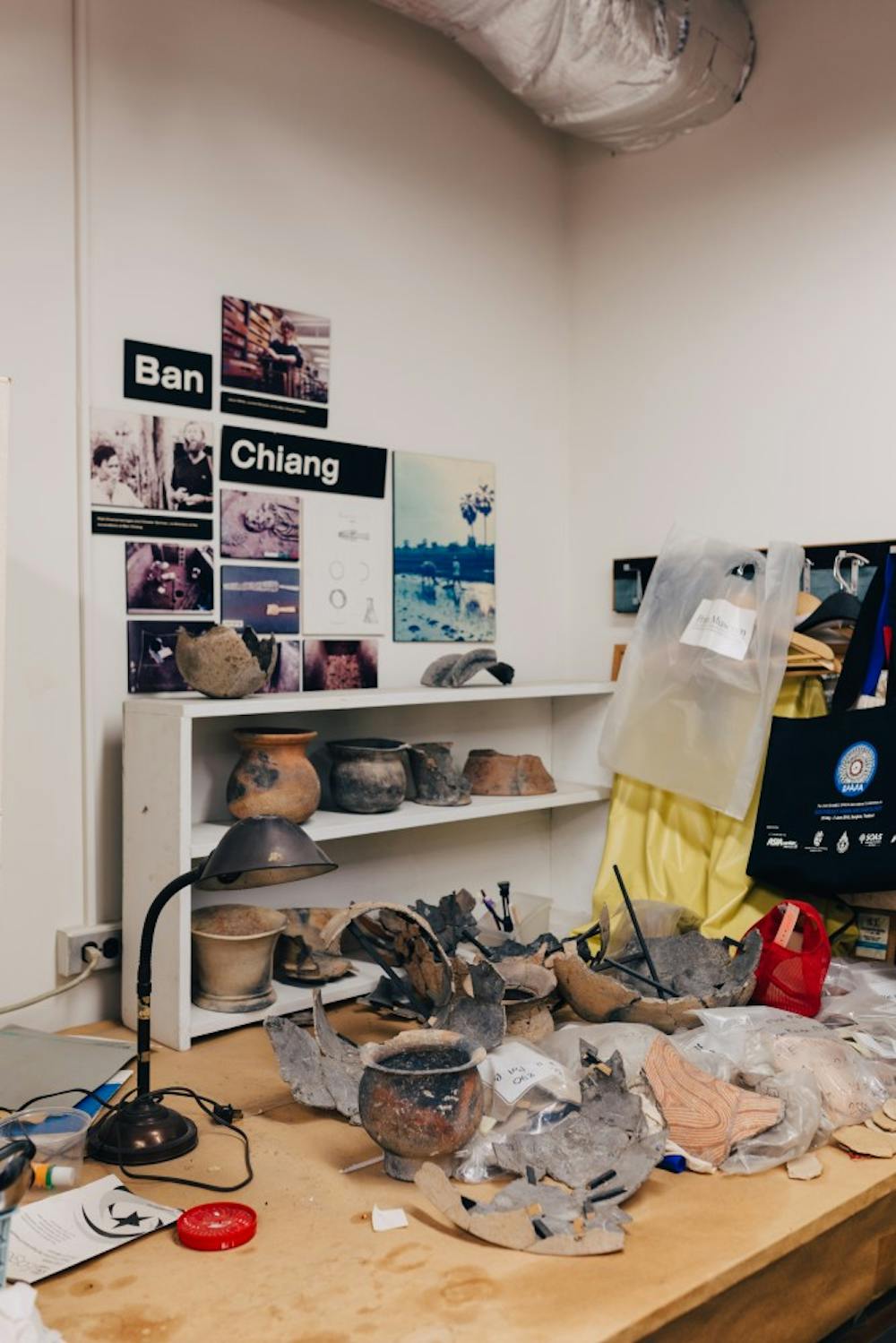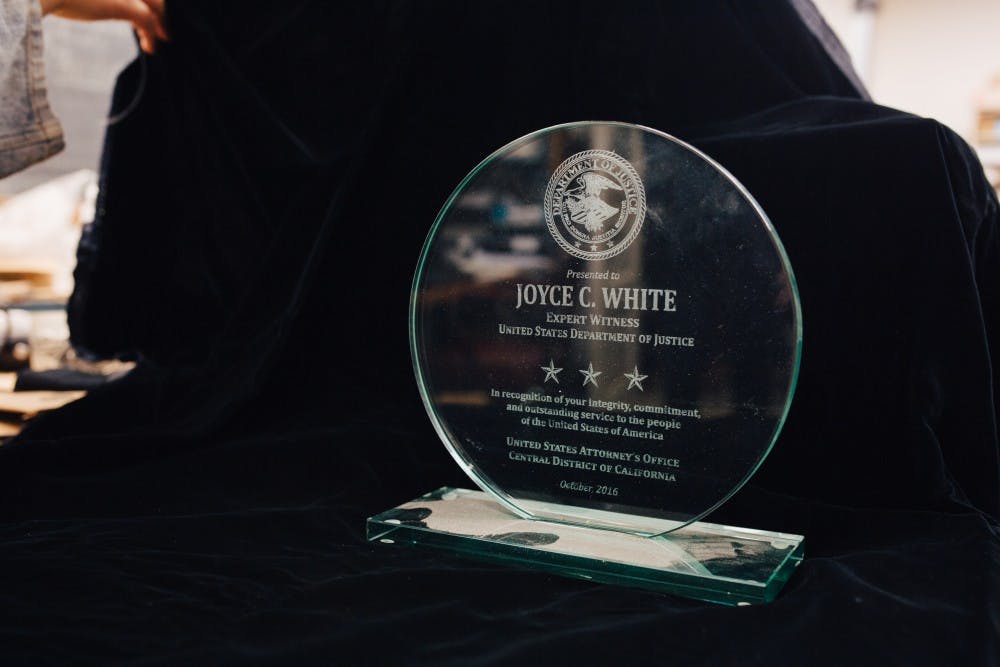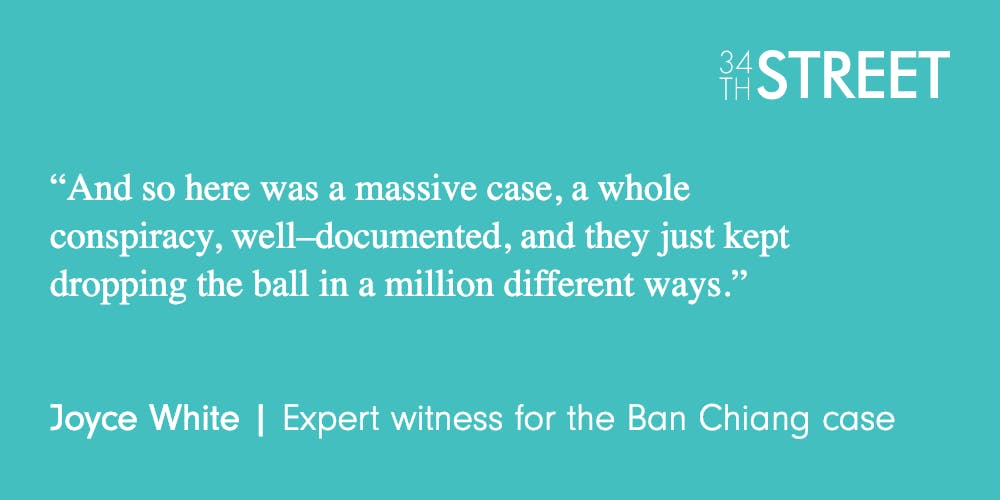“Ban Chiang Project!” That day in July 2005, the voice on the other end of the phone caused her to do a double–take: “This is the Department of Homeland Security looking for Joyce White.”
The woman with white hair and soft features is indeed Joyce White, Ph.D., founder of the Institute of Southeast Asian Archaeology (ISEAA) at the University of Pennsylvania. But that day, instead of affirming this, she said: “I think you have the wrong number.”
“Is this Joyce White?”
“... Yes.”
“Are you an expert on Ban Chiang?”
“... Yes,” she said, mimicking her hesitation as she re–enacts the conversation.
“You can imagine what’s going on in my mind. It’s not that far from 9/11, it’s the Department of Homeland Security, my god! What is the Department of Homeland Security doing with Ban Chiang?”
They were finally closing in on a smuggling ring that for years had been bringing in stolen artifacts from the Ban Chiang archaeological site in Thailand.
She, Joyce White, Ph.D. and archaeologist, was the world’s leading expert on the place. They needed her on the case.
From 2005 to 2016, White assisted the Department of Homeland Security as an expert witness in one of the biggest recent smuggling cases in the United States: Operation Antiquity.
“They said, ‘Well, will you come out for a little visit, a couple nights?’ So I said OK! I mean, a free flight to California, can’t turn that down…
“So somebody was gonna be sent to pick me up at 9 a.m. And we are walking to the car–it’s this white Chevy Tahoe parked across the street. And I thought, ‘This is the stupidest thing I’ve ever done in my life, getting into a car in a city I don’t know....’ And so I’m racking my brain as to what to do, but I’m trying to be polite at the same time.
So we get in the car, I’m in the front seat, and I say, ‘How do I know that you’re not kidnapping us?’ And he said, ‘I guess you need our credentials.’ So he whips out, you know, his thing with the badge and everything. Anyways. That’s just the beginning.”
That day, White and her student were asked to identify an estimated several hundred artifacts. Over the next 11 years, she would identify more than 10,000.
Dr. Joyce White spent years of her life trekking through the fields of northern Thailand, researching the Ban Chiang archaeological site. Years later, the field of her intellectual scrutiny became the epicenter of a global controversy.
Jonathan and Carolyn Markell were involved in smuggling hundreds of artifacts, from clay pots to bronze Buddhas, from the Ban Chiang site, before appearing in court in 2015. White, as an expert on the area, became an integral part of the investigation, identifying artifacts and testifying in court to ensure the return of these ancient objects to their rightful place.
Here’s how, in 2005, a Penn archeologist became an expert witness in one of the most visible international smuggling cases in history, and how the complex issue of artifact repatriation–of whether relics belong to museums or to the cultures they came from–plays into the politics of museum curation today.
White hadn’t even planned on studying Southeast Asian archaeology. When she first got to graduate school at Penn in 1974, she had been planning to do her dissertation in European archaeology. It was only for the sake of a part–time job that she started working under Chet Gorman, the leading archaeologist on the Ban Chiang site at the time. A few years in, White got her own office in the basement of the Penn Museum.
Since then, every adventure she’s been on has started in this office. It’s a cozy space with up to six people filling the two little rooms, often shuffling between computers. All around are ceiling–high cabinets overflowing with post–it notes, monographs, and National Geographic issues. The plaque outside bears White’s name and the name of the institution she founded: the Institute of Southeast Asian Archaeology, or ISEAA.
White hasn’t always felt quite so passionately about her work. “It was the most boring job on Earth,” she says. But one day, she witnessed Gorman giving a talk on his work to a small group, and saw a slide that captured her attention instantly. “I saw that slide, and I said: ‘Oh my god, this is me.’”
The slide showed Gorman walking his donkeys into a cave, lugging his material, passing rich jungles and fields where people were growing opium. (“Now, I have no interest in opium–I mean, maybe I would’ve at a younger age, but really that’s not my motivating thing.”)
She knew that this was where she wanted to be, and now she had a plan: she would go to the Ban Chiang site in northern Thailand to pursue plant–based archaeological research for her dissertation.
So she switched out of her European archaeology classes (“That professor was boring, this was interesting.”) and walked into Gorman’s office asking him to be her advisor.
“I don’t want any female graduate students,” was his answer. But White did what she does best: she persevered, and Gorman gave in.
Seven years later she was in northern Thailand, studying plants at the Ban Chiang site. It was a simple, “grueling but wonderful” life: she lived in a little house with a breezy downstairs and a shack–like kitchen in the back, working alongside a local farmer Long Lee (“Uncle Lee”) identifying plants and writing up her research. The isolation was pleasing. She was miles away from any major city, and finally surrounded by the fields she had first dreamt of years ago in the Penn Museum basement.

It was by sheer luck, then, that White passed by the post office on that day in 1981. Normally, she only walked that far every two weeks. But that morning she stopped by and saw a telegram addressed to her, reading: ‘GO TO BANGKOK TO HELP WITH SMITHSONIAN EXHIBIT.’
Gorman had passed away. He had been sick with melanoma for several months. Now, his position as as a guest curator at the Smithsonian Museum urgently needed to be filled. White was quickly summoned to complete the task.
Meanwhile, the board of directors at the Penn Museum were conflicted over who should take over the Ban Chiang research. “One professor said to me, ‘What are we gonna do? What are we gonna do?’ I said, ‘Well, you know, I’m the one who knows the most about the site, I’m the logical person.’” Today, White remembers her professor’s reply with a mischievous relish: “‘That’ll never happen! You’re too young, you’re a student, and you’re a woman!’”
A few days later, that very same professor stood behind the director of the Penn Museum as he asked White to change her dissertation topic from plants to the chronology of Ban Chiang. “It’s interesting how things turn out,” she cackles. She took charge of the Ban Chiang site, and hasn’t stepped down since.
When the raids finally happened in 2008, White had been acting as expert witness in Operation Antiquity for three years. The investigators would send her pictures of artifacts for her to identify, usually just a few every month or so. The process seemed painfully slow.
“At one point there was this whole slew of [pictures]. I said, ‘You’re just letting Thailand be looted to pieces,’” she recalls. “And they kept saying ‘Oh, this’ll wrap up in a few months …’ and then a few months later, the same thing.”

In late December 2007, she got another fateful phone call: They were ready to do the search warrants.
They flew her to Chicago—“Chicago! I didn’t even know that was part of the case. They tell you as little as possible and you never know what’s going to happen.”
They went over the details in the parking lot of a mall. It was around –25 degrees Fahrenheit. They sat in a car, waiting for the ‘go’ to them and the 12 other teams back in Los Angeles that would be coordinating the raids at the exact same moment. Finally, at 8:30 p.m., they got the signal.
“So people pile into the cars, and I’m in the first car. Everybody has a bulletproof vest but me–the guy driving my car has two bulletproof vests. Finally the whole train of cars gets to some kind of secluded wood. And the garden is full of Cambodian statues, just out there.
“This was the private museum of this guy, the collector, whose name is McKlein. The team is creating a spreadsheet on the fly, they keep checking their computers. It was just extremely intense, assigning things for hundreds of objects to periods and time frames.
“I was the only person to do this, recording the culture, age, time period, authentic or not … In this case they were targeting what to focus on, and we only got a quarter of the stuff. It was around 2:30 a.m. I thought I had more time–and then they flew me to Los Angeles. It just goes on and on and on.”
Catching artifact smugglers is one thing. Repatriating objects that museums actually purchased is another. Nevertheless, White notes that the two are closely linked.
She says with some pride that since Operation Antiquity, Thailand has been actively trying to recover stolen artifacts from Western museums. In November 2018, Thailand’s culture minister announced that it was seeking the return of 23 antiquities that are currently in museums across the United States, including New York’s Metropolitan Museum of Art.
The Penn Museum has been actively involved in the efforts to prevent collection of objects acquired through looting and plundering. The 1970 Pennsylvania Declaration states that the Museum “would purchase no more art objects for the Museum unless the objects are accompanied by a pedigree–that is information about the different owners of the objects, place of origin, legality of export, and other data useful in each individual case.” Months later, UNESCO would release a convention to prevent the same kind of thing.
However, the execution is not always so simple. On January 11, 2017, the Zhaoling Museum in China posted a message on its public WeChat page, calling for the Penn Museum to return two famous stone reliefs called the “Taizong Horses” or “Tang Horses.” The two horses, which the Penn Museum acquired in the 1920s, are part of a six–horse set, which were originally found together at the Mausoleum of the Tang Emperor, Li Shimin, dating back to the 7th century.
In January 2019, students noticed an unsigned and undated flyer being circulated across campus. The flyer called for the two horses’ immediate return to China without explicitly mentioning the museum. “The six horses are objects of repeated research in Chinese history, sung in poetry and literary writings,” reads the flyer. “They are an integral part of Chinese culture and a depository of spirit of the people.”

The Penn Museum bought the horses from a Chinese art dealer C. T. Loo in 1921. The flyer calls this transaction illegal, stating that according to the 1970 UNESCO declaration, “the theft and sale of the two horses were themselves crimes, as is smuggling them to the USA. UPenn buying them does not make the illegal legal.”
Adam Smith, an assistant professor and curator of the Penn Museum Asian section, is irked by such demands, which he says surface occasionally but never actually reach the Museum in any official capacity. He acknowledges that there is sometimes “an asymmetry between the museum and the people who produced the object.” But the primary role of a museum, he says, is to educate and tell the truth. Smith also notes that the 1970 UNESCO declaration, which the flyer references, was in fact spearheaded by the Penn Museum.
After having seen first–hand the amount of work that goes into the legal process of valuation throughout Operation Antiquity, White is all too aware that the repatriation of artifacts is a lengthy process, with little legal precedent.
She admits that the two cases are different on the surface–while Operation Antiquity dealt with cut and dry smuggling by Americans, the two horses in the Penn Museum were actually sold by a Chinese art dealer. How the dealer himself acquired the pieces, however, is unclear. In an email to the Daily Pennsylvanian in 2017, Penn Museum Williams Director Julian Siggers wrote that he was not aware “exactly whose hands [the reliefs] passed through before the Museum was involved.”
In an interview with artnet, White echoed the Pennsylvania declaration in advising transparency: “Shining a light on this murky area of the museum world will hopefully be a trend in the 21st century. If museums have clear legal backing for particular acquisitions, they can make their case in a court of law. Transparency should not be a problem for them.”
It was December 2015 when Operation Antiquity finally came to court. Jonathan and Carolyn Markell, an elderly couple who had been actively involved in smuggling, pleaded guilty. All that was left to be determined was whether or not Jonathan Markell would be sentenced to jail time.
White says that the judge appointed to the case, Dean Pregerson, was notorious for giving no jail time at all. The room was full of people, and they were not on the prosecutor’s side. Scores of the Markell’s friends and family (“and two Buddhist monks of different faiths!”) filled the pews, anxious to hear the decision.
White came up to the bar. She was asked, again, to confirm the authenticity of the objects, to reaffirm their value, to tell the court about the exorbitant cost that it would have taken to excavate them as part of a professional study.
The investigator came up, introduced himself, and played three tapes he had of the couples admitting full knowledge of their crime, which he had taken while operating undercover.
The evidence was incontrovertible. In the end, the judge sentenced Jonathan Markell to 18 months in jail for smuggling of antiquities and tax evasion.
“In my view,” says White, speaking more slowly, “it then became so sad that they did not properly pursue this case. In the end, they just didn’t have the stomach to go after the people … So often, these smugglers … they just get slapped on the wrist, or no one understands the value, or so on.”
“I think prior to this case only one collector–dealer type ever served prison time. Only one. And so here was a massive case, a whole conspiracy, well–documented, and they just kept dropping the ball in a million different ways.”

After the kind of life she’s had, spent fighting her way through sexism and bureaucracy, White isn’t one to understand why you would do anything only to stop halfway through. On her shelf is a print–out of a quote by Mahatma Gandhi: “First they ignore you, then they laugh at you, then they fight you, then you win.”
A pause, and then she adds: “You know, there were numerous flaws in the proceedings and some such that the Chicago people, the material was actually returned to them, because of the legal flaws, and I just …” she drifts off, unable to continue.
Then she sits up. “Well, it’s a great story. I told the investigator several times, ‘The book, the movie! The book, the movie!’”
He wasn’t as enthusiastic, but of course, that would never stop Joyce White, Ph.D., leading archaeologist on the Ban Chiang excavation site in northern Thailand.
“Maybe I’ll get around to it someday,” she muses. “But right now, I still have a lot on my plate.”
Meerabelle Jesuthasan is a senior in the College. She is the long–term features editor for Street.
